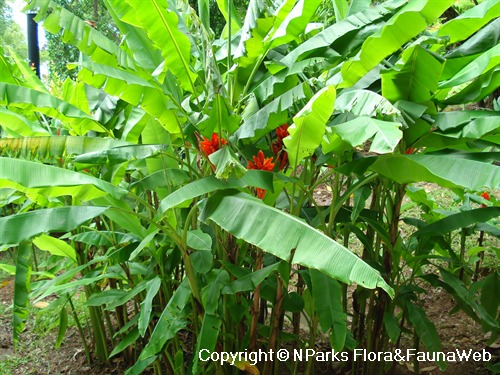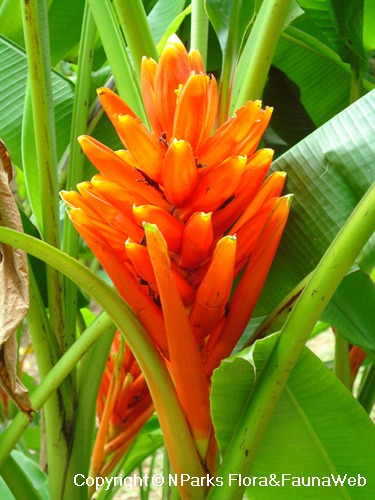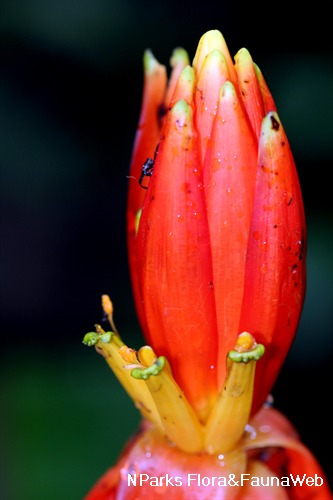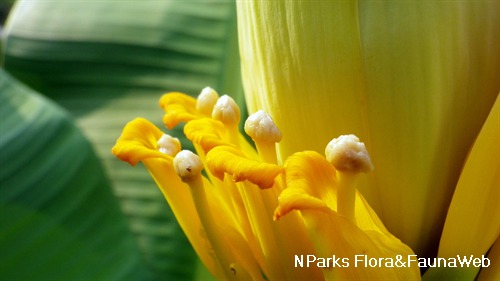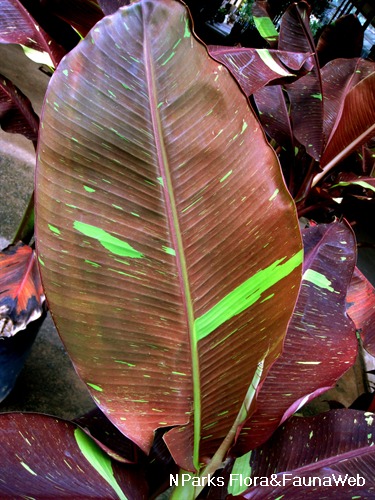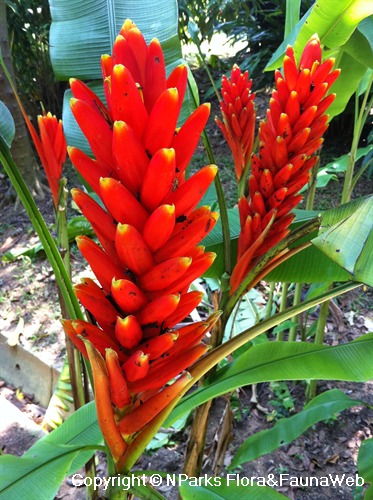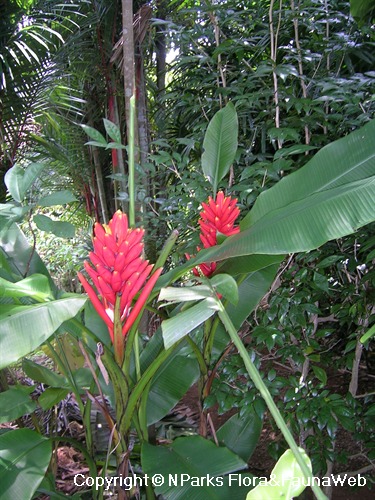
Back
Musa coccinea H. C. Andrews
| Family Name: | Musaceae |
| Synonyms: | Musa uranoscopus |
| Common Name: | Flowering Banana, Red Banana, Scarlet Banana, Red flowering Thai banana, 红蕉, 红花芭蕉, 美人芭蕉 |
Name
Classifications and Characteristics
| Plant Division | Angiosperms (Flowering Seed Plants) (Monocotyledon) |
|---|---|
| Plant Growth Form | Herbaceous Plant |
| Lifespan (in Singapore) | Perennial |
| Mode of Nutrition | Autotrophic |
| Plant Shape | Umbrella |
| Maximum Height | 1.5 m |
Biogeography
| Native Distribution | Indochina |
|---|---|
| Native Habitat | Terrestrial (Secondary Rainforest) |
| Preferred Climate Zone | Tropical |
Description and Ethnobotany
| Others - Plant Morphology | Pseudostems that are devoid of wax can reach a height of 1.5 m tall. Leaves are glossy and light green on the upperside and can attain a length up to 1 m long, which narrow gradually to a rounded apex and are also rounded at base with the right side usually longer than the other. Numerous suckers are produced close to the mother plant to make a tight clump of plants.An attractive, erect inflorescence is produced and the flower stalk scarcely emerges from the sheath of the subtending leaf. Inflorescence consists of a cone of loosely open, red coloured bracts that each has a yellow tip.Fruits are oblong and measure about 5 cm long with persistent withered perianths still attached to the tip. Turn orange-yellow when ripe with a waxy bloom . Pulp inside is white. Seeds are black, small and almost cylindrical in shape.Used as a focal plant or for mass planting. Suitable for containers.Plant prefers to be grown in a semi-shaded location as leaves can burn when grown under full sun. Shadier conditions result in taller plants. Protect plants from wind. Well-drained and fertile soil is required. Feed generously to promote growth and keep roots moist using a layer of organic compost. Propagated via suckers and division. |
|---|
Landscaping Features
| Desirable Plant Features | Ornamental Flowers |
|---|---|
| Landscape Uses | General, Focal Plant, Container Planting |
Plant Care and Propagation
| Light Preference | Semi-Shade, Full Sun |
|---|---|
| Water Preference | Lots of Water |
| Plant Growth Rate | Moderate |
| Rootzone Tolerance | Fertile Loamy Soils, Well-Drained Soils |
| Maintenance Requirements | Moderate |
| Propagation Method | Seed, Sucker, Division |
Foliar
| Foliage Retention | Evergreen |
|---|---|
| Mature Foliage Colour(s) | Green |
| Mature Foliage Texture(s) | Smooth, Glossy / Shiny |
| Foliar Type | Simple / Unifoliate |
| Foliar Arrangement Along Stem | Rosulate / Rosette |
| Foliar Shape(s) | Non-Palm Foliage (Oblong) |
| Foliar Venation | Pinnate / Net |
| Foliar Margin | Entire |
| Foliar Apex - Tip | Acute |
| Foliar Base | Oblique / Asymmetrical |
| Typical Foliar Area | Mesophyll ( 45cm2 - 182.25 cm2 ) |
| Leaf Area Index (LAI) for Green Plot Ratio | 3.5 (Shrub & Groundcover - Monocot) |
Non - Foliar and Storage
| Trunk Type (Non Palm) | Non Woody |
|---|---|
| Root Type | Underground (Fibrous Root) |
Floral (Angiosperm)
| Flower & Plant Sexuality | Unisexual Flowers , Monoecious |
| Flower Colour(s) | Red |
|---|
| Inflorescence Type | Panicle |
| Flowering Habit | Monocarpic |
Fruit, Seed and Spore
| Mature Fruit Colour(s) | Yellow / Golden |
|---|---|
| Fruit Type | Fleshy Fruit , Berry |
Image Repository
Others
| Master ID | 949 |
|---|---|
| Species ID | 2243 |
| Flora Disclaimer | The information in this website has been compiled from reliable sources, such as reference works on medicinal plants. It is not a substitute for medical advice or treatment and NParks does not purport to provide any medical advice. Readers should always consult his/her physician before using or consuming a plant for medicinal purposes. |

